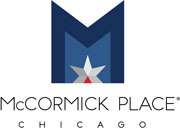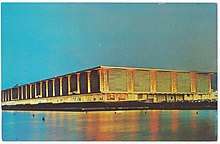McCormick Place
McCormick Place is the largest convention center in North America.[2] It consists of four interconnected buildings and one indoor arena sited on and near the shore of Lake Michigan, about 2 mi (3.2 km) south of downtown Chicago, Illinois, United States. McCormick Place hosts numerous trade shows and meetings. The largest regular events are the Chicago Auto Show each February, the International Home and Housewares Show each March and the National Restaurant Association Annual Show each May.
| McCormick Place | |
|---|---|
 | |

| |
| Address | 2301 S. Lake Shore Drive |
| Location | Chicago, Illinois |
| Coordinates | 41°51′07″N 87°36′58″W |
| Owner | MPEA |
| Built | 1958 |
| Opened | November 1960 |
| Expanded | 1986 1997 2007 2017 |
Construction cost | $2 billion |
Theatre seating | 4,250 (Arie Crown Theater) |
| Enclosed space | |
| • Exhibit hall floor | 2,670,000 sq ft (248,000 m2) |
| Parking | 3 lots, 5800 total spaces[1] |
| Public transit access | |
| Website | |
| mccormickplace | |
History
As early as 1927, Robert R. McCormick, a prominent member of the McCormick family of McCormick Reaper fame, and publisher of the Chicago Tribune, championed a purpose-built lakeside convention center for Chicago. In 1958, ground was broken for a $35 million facility that opened in November 1960, and was named after McCormick, who died in 1955. The lead architect was Alfred Shaw, one of the architects of the Merchandise Mart.[3] This building included the Arie Crown Theater, designed by Edward Durell Stone.[4] It seated nearly 5,000 people and was the second largest theater (by seating capacity) in Chicago.

The 1960 exposition hall was destroyed in a spectacular fire on January 16, 1967, despite being thought fireproof by virtue of its steel and concrete construction.[5] At the time of the fire, the building contained highly combustible exhibits, several hydrants were shut off, and there were no sprinklers on the main floor where the fire started. Thus the fire spread quickly and destructively, taking the life of a security guard.[6] The fire was investigated by a team led by Rolf H. Jensen, Professor of Fire Protection Engineering at the Illinois Institute of Technology, who later went on to found RJA Group. Many lessons were learned and the city's building code was amended so a similar situation would not be repeated. Although many wanted to rebuild the hall on a different site, Chicago mayor Richard J. Daley elected to rebuild on the foundations of the burned building. The new design of dark steel and glass, by Gene Summers of C. F. Murphy and Associates (and formerly of Mies van der Rohe's office) contrasted markedly with the white look of the structure that had burned. On January 3, 1971, the replacement building, later called the East Building and now called the Lakeside Center, opened with a 300,000 square feet (28,000 m2) main exhibition hall. The Arie Crown Theatre sustained only minor damage in the 1967 fire, and so was incorporated into the interior of the new building. The theater, with the largest seating capacity of any active theater in Chicago (the Uptown Theatre having more seating, but currently closed), underwent major modifications in 1997 which improved its acoustics.
On March 27, 2020, the United States Army Corps of Engineers announced that the complex would begin transforming convention space into a 3,000-bed hospital in the wake of the COVID-19 crisis affecting the Chicago area. The $15 million project is being paid for by FEMA and is scheduled for completion on April 30.[7]
Additions
The North Building, located west of Lake Shore Drive and completed in 1986, is connected to the East Building by an enclosed pedestrian bridge. In contrast to the dark, flat profile of the East Building, the North Building is white (as the original building was), with twelve concrete pylons on the roof which support the roof using 72 cables. The HVAC system for the building is incorporated into the pylons and give the building the appearance of a rigged sailing ship. The North Building has approximately 600,000 sq ft (56,000 m2) of main exhibition space.
The South Building, dedicated in 1997 and designed by tvsdesign, contains more than 1 million sq ft (93,000 m2) of exhibition space. It more than doubled the space in the complex and made McCormick Place the largest convention center in the nation. The South Building was built on the former site of the McCormick Inn, a 25-story, 619-room hotel built in 1973 as part of the McCormick City complex and demolished in 1993.[8][9]
On August 2, 2007, McCormick Place officials opened yet another addition to the complex, the West Building, also designed by tvsdesign and costing $882 million and completed eight months ahead of schedule. The publicly financed West Building contains 470,000 square feet (44,000 m2) of exhibit space, bringing McCormick Place's total existing exhibition space to 2.67 million square feet (248,000 m2). The West Building also has 250,000 square feet (23,000 m2) of meeting space, including 61 meeting rooms, as well as a 100,000 square feet (9,300 m2) ballroom, the size of a football field and one of the largest ballrooms in the world.
McCormick Place continued to expand in October 2017 with the opening of Wintrust Arena, a 10,387-seat arena situated on Cermak Road just north of the West Building. The new facility hosts DePaul Blue Demons men's and women's college basketball, and the WNBA's Chicago Sky. The new arena boasts 22 suites, 479 club seats, and 2 VIP lounges. The arena is also equipped to host concerts, sporting events, meetings, and conventions in conjunction with the rest of the McCormick Place complex.[10] Sporting events such as gymnastics and volleyball are also held in the McCormick Place buildings in addition to the arena.[11]
Archival materials are held by the Ryerson & Burnham Libraries at the Art Institute of Chicago. The McCormick Place on the Lake 1971 Collection includes photographs, drawings and project files documenting its construction.
South of the center is McCormick Place Bird Sanctuary, created in 2003.[12] The northern end includes a recreated prairie, covering the roof of the center's underground carpark, and so requiring the use of shallow-rooted plants.[12]
Public transit
The Metra Electric Line stops at a station in the basement of McCormick Place. The South Shore Line also stops at the same station on weekends. The Chicago Transit Authority serves the facility with its Cermak–McCormick Place station on the Green Line, approximately 1⁄2 mile west, and two bus routes.[13]
Busway
The McCormick Place Busway runs 2.5 miles (4.0 km) from Lower Randolph between Michigan and Columbus in downtown Chicago to the center.[14][15][16] It uses the lower levels of the multilevel streets near downtown, and surfaces to follow the Metra Electric District right-of-way to outside the South Building of McCormick Place. Opened in 2002 at a cost of $43 million, it is meant to provide a fast way for visitors to move between northerly hotels and the convention center, but is also used by buses to Soldier Field, public safety workers, Metra, convention contractors, Art Institute deliveries, and occasionally government officials.[15][17] It is also known as the "Mayor's Road", the "Bat Cave", the "Magic Road"[15] and a "secret road".[16] Road use is administered by the Chicago OEMC (Office of Emergency Management and Communications), and regular users are granted access cards.[17] The convention center advertises the road as a benefit to potential customers.[15][17]
Gallery
- South Building from Lake Shore Drive looking northwest in 2007
- West Building looking northwest from King Drive and 24th Place in 2007
- West Building looking southeast from Indiana and Cermak (22nd St) in 2007
References
- "Getting to McCormick Place". McCormick Place. Retrieved May 7, 2014.
- "United States Convention Centers (250,000 - 2.5 Million Square Feet)". Cvent. Archived from the original on January 8, 2012. Retrieved March 23, 2020.
- Cowan, David (2001). Great Chicago Fires: Historic Blazes that Shaped a City. Lake Claremont Press. p. 102. ISBN 978-1893121072.
- "E. D. Stone entry at archiplanet". Archived from the original on June 4, 2008. Retrieved June 19, 2008.
- Benzkofer, Stephan (February 5, 2012). "The night McCormick Place burned". Chicago Tribune. Retrieved March 23, 2020.
- Cowan (2001), chpt. 12.
- St. Clair, Stacy; Gregory Pratt; Jamie Munks (March 30, 2020). "Illinois tops 5,000 coronavirus cases as construction on a McCormick Place field hospital begins". Chicago Tribune.
- Steffes, Patrick (June 30, 2013). "Chicago's Shoreline Motels – South". Forgotten Chicago. Retrieved March 23, 2020.
- "Throwback Thursday – McCormick Inn". EpsteinGlobal.com. January 22, 2015. Retrieved August 2, 2018.
- "New for 2017-18: Wintrust Arena". ArenaDigest.com. November 17, 2016. Retrieved March 23, 2020.
- "Events". McCormick Place. Retrieved March 23, 2020.
- "Bird Sanctuaries – Things to See & Do". Choose Chicago. Retrieved May 16, 2014.
- "Public Transportation" (PDF). McCormick Place. Archived from the original (PDF) on March 24, 2018. Retrieved March 23, 2020.
- PDF map
- Corley, Cheryl (July 24, 2013). "Bat Cave' Road In Chicago Accessible To Only A Few". All Things Considered. NPR.
- "McCormick Place Busway". Yelp. May 30, 2013.
- "Five ways cash and power can help you beat the crowds in Chicago". Chicago Sun-Times. August 30, 2016.
External links
| Wikimedia Commons has media related to McCormick Place. |